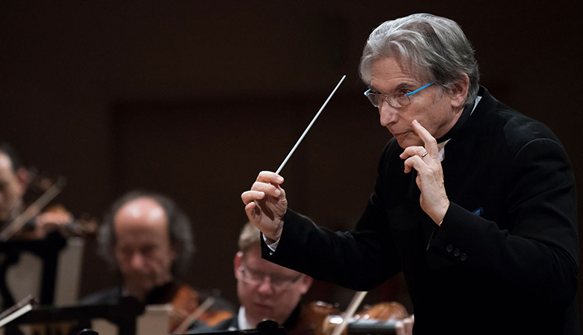
A CONDUCTOR CARRIED AWAY
There he was in a full-body resonant thrill, something never witnessed in some 10,000 concerts I’ve attended. His whole body trembled ecstatically as he raised his vehemently shaking fists on high during the ocean-swell ovations for the Mahler Fifth just concluded. No, not a seizure. Just an energized attack of great classical music.
With his departure a bit more than two years away, Music Director Michael Tilson Thomas, 73, realizes that each time may be his last leading that composition with the San Francisco Symphony, which he has led since the 20th century. The Fifth is a pinnacle work undeniably, and the performance by his players was exemplary to boot.
The astute program pairing had, next to the Mahler, Berg’s 12-tone Violin Concerto, a memorial work that is the most performed of the orchestral 12-tone pieces. Its heavy message led smoothly into the Mahler, which begins with tragedy in spades, goes on to a tug-of-war between minor and major, and ends up sunny and exultant, dancing its way through the 5th and final movement; it is an eloquent, multi-faceted work that this concert-goer can never hear too often. These two are milepost works of the earlier 20th century, breaking away from earlier forms.
The strings were celestial in the soulful string serenade of Mahler’s Adagietto, the augmented brass section (seven horns!) invincible throughout, and the finale, with its tempo shifts and eccentric interjections suggesting a dance gala gone wild, all but blowing the roof off Davies Hall.
Mark Inouye led off the Fifth with the funeral march and his sterling trumpet suggesting military discipline. Easily overlooked is the ingenious second movement, a stormy maelstrom with a battle of minor-vs.-major, the latter emerging victorious and euphoric—turning about the whole thrust of the 76-minute symphony. The cello section was admirable. Through, MTT led the ensemble with command and color; the players responded to perfection.
The preceding Berg Violin Concerto (1935) is a trifecta, a brilliant conjunction of themes. As a memorial piece to a young girl who died young, it quotes J.S. Bach’s Cantata No. 60, itself a work in mourning. Furthermore Berg discovered that part of Bach’s musical line exactly matched his own 12-tone sequence. And in the final convergence, Berg himself died the same year. Thus the Berg/Bach concerto ends up a three-way commemoration.
Soloist in the Berg was violinist Gil Shaham, who clearly loves the work despite its technical complexities. Shaham worked so hard however at blending into the ensemble and at times his play became virtually inaudible—an approach that was unique in my experience with this piece.
POSTLUDE—The same program with Shaham will be repeated on tour March 27-29 in three Southern Californian venues.
S.F. Symphony in Berg, Mahler, through March 25. Davies Hall, S.F. For SFS info: (415) 864-6000, or go online.